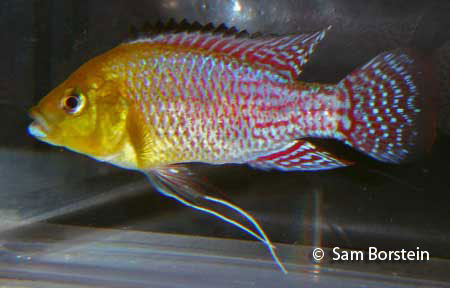Pseudocrenilabrus nicholsi
(Pellegrin, 1928)
Nichols' Dwarf MouthbrooderSynonyms: Pseudocrenilabrus ventralis

Above: A male Pseudocrenilabrus nicholsi. Photo by Sam Borstein.
Etymology:
Genus- Pseudo=fake (Greek), crenilabrus= cut lip (Latin).
Species- nicholsi= named after John Nichols.
Intro:
Pseudocrenilabrus nicholsi is a striking looking West African cichlid. This fish is considered a dwarf cichlid even though it technically is not. This mouthbrooder over the years has gotten recognition, and is becoming more available.
Distribution:
Pseudocrenilabrus nicholsi is found in still waters in West Africa where in both slightly acidic (pH 6.0) to higher end basic (pH 9.0) water. This fish inhabits Lakes Upemba and Ankoro in the Democratic Republic of the Congo (Lamboj, 2004).
Size, Maturity, and Sexual Dimorphism:
Size: Males- 4 inches, Females- 2.5 inches
Maturity: 1 inch
Sexual Dimorphism: Males are larger than females and are a lot more colorful than the females which are silver.
Care:
Even though this is a small fish, they have plenty of aggression. Pseudocrenilabrus nicholsi can easily be kept and bred in a 20 gallon tank with plenty of rocks. As they get larger a 40 would be better because with age the fish get more aggressive. Male Pseudocrenilabrus nicholsi will chase each other all day, so lots of hiding places need to be added.
Pseudocrenilabrus nicholsi can easily be mixed with rift lake cichlids. I've had luck keeping them with mbuna and haplochromines in the past.
Diet:
This fish is not picky. This fish is omnivorous and in the wild feeds on algae and insect larvae. Feed a little bit of everything and they should do fine.
Breeding:
The fish was not hard to breed. Pseudocrenilabrus nicholsi will breed small, an inch long. Males at this point will be close to full color. The males look even better when spawning and displaying for a female. Spawning occurs in the T position in a pit dug by a male. The fish had very short incubation period of 11 days, and the fry were very small. Spawns ranged from 6-10 babies. Babies ate newly hatched brine shrimp. They grow fast and by .5 an inch are coloring up.
Conclusion:
Pseudocrenilabrus nicholsi is an amazing fish. Not only will they add some color to your tank, but they will add some action. If you see this fish I highly recommend you try it. It is semi-available through hobbyists. This species, although more aggressive than Pseudocfrenilabrus multicolor multicolor, still makes a good fish for someone starting with West African cichlids that has knowledge of rift lake cichlids.
References:
- Lamboj, A. (2004). The Cichlid Fishes of Western Africa. Bergit Schmettkamp Verlag, Bornheim, Germany, 255 pp.
